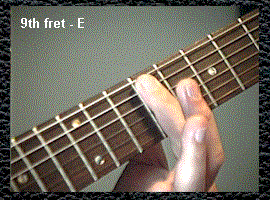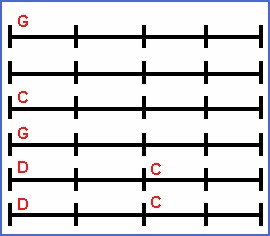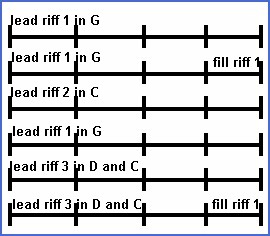
ROCK LEGENDS I - KEITH RICHARDS
Lesson Sample
Lyle: He has nine lives and 5 strings and he
plays lead guitar in the world's greatest rock 'n roll band. He is Keith
Richards. Born on December 18th, 1943 in Dartford,
England, Richards began playing guitar in bands by the time he was a teenager.
In 1962 he formed the Rolling Stones with his childhood friend Mick Jaggar.
Keith's musical influences come mostly from the early American blues guitar
heroes such as Chuck Berry, Willie Dixon and Muddy Waters to name just a
few.
Lyle: His main guitar is an early '50s Fender
Telecaster. It only has 5 strings, the 6th string is removed and it's always
tuned to open G (G, D, G, B, D) low to high. String gauges are .011, .015, .018,
.030, .042. He uses both Marshall and Fender amps,
Marshalls for the dirty tone and Fenders for the clean tone, most of the time
playing through both at the same time. Suggested listening: Honky
Tonk Woman, Gimme Shelter, Satisfaction, Start Me
Up.

Lyle: We are going to be working in
the open G tuning for this lesson. Just like Keith, you wont use the 6th
string on your guitar, just the other 5.
Lyle: Tune the 5th string
down a whole step to G, then tune the 1st string
down a whole step to D. So you end up with G - D - G - B
- D from low to high. Use this audio clip to match
your tuning:
open
G tuning
Lyle: The open tuning makes playing barre
chords up and down the neck real easy by just using one finger to barre across
the 5 strings. Here's an example of a bunch of chords
you can play. The root note of the chord is on the 5th string. Remember it's
tuned down a whole step, so the name of the note is different than what you're
used to.
Lyle:
By using a couple fingers and adding notes, you can get the "Keith Richards"
chord change as I call it. Look close at this next
tab:
chord riff

Lyle: You're simply playing an E major chord
then changing it up a 4th to an A major type chord. Many of Keith's songs use
this tuning and chord change. Watch this next video clip of me just
moving around the neck with these chord changes:
chord riffs
Lyle: Now you try doing this on your own.
Improvise this chord riff up and down the neck and you'll hear that familiar
Stones sound come to life on your guitar. I suggest you have your amp set to a
clean sound with just a small amount of drive.

Lyle: Next I'd like to show you how
to play the lesson sample from above. It's very much like a 12 bar blues
progression but a little longer, 24 bars. It still uses the 1 - 4 - 5 chords in
the key of G - (G, C, D). Learn these 3 chord changes for
the 1 - 4 - 5 chords in G. Here's the basic chord change you need to use for the
G chord at the open position:
Lyle:
Do the same chord change for the C at the 5th fret position and D chords at the
7th fret position:
Lyle:
Now that you know where to play the 3 chords for G, C and D, you'll need to know
how to play them. Here's a jam track with the rhythm
guitar parts you'll be learning:
Looping Sound Clip 1
Lyle:
Here's a chord
chart of the 24 bar jam track for you to study:
chord chart

Lyle: For the G chord, this
is the rhythm part:
rhythm riff 1 in
G
Lyle: The C chord rhythm part is a little
different. It goes like this:
rhythm riff 2 in
C
Lyle: For the D chord, you'll need to know
this rhythm part. Play it twice through.
rhythm riff 3 in
D and C
Lyle: After you become familiar with the 3
different rhythm parts, practice them with the jam track until you are able to
play along with the guitar on it. It should sound like one big rhythm guitar
part.
Lyle: If you would like to make up
your own rhythm riffs, here's a jam track without the guitar:
jam - no guitars

Lyle: Let's look at a few lead
riffs. Against the G chord you could play a
riff like this in the style of Keith:
lead riff 1 in G
Lyle: Try playing the lead riff you just
learned but sub the ending with this
riff:
riff fill 1
Lyle: Over the C chord you can play this
riff:
lead riff 2 in C
Lyle: At the end of the progression, the D to
C changes, you will play this riff:
lead riff 3 in D
and C
Lyle: Now repeat the last riff and throw in
the fill riff you learned earlier. Here's a video
clip:
lead riff 4
in D and C
Lyle: Here's a lead riff chart that might help
you see where and when to play the different parts over the
changes:
lead riff
chart

Lyle: Don't worry if you are having trouble
with the rhythm or lead riffs, just learn what you can and have fun making up
your own variations of the Keith Richards style using this
tuning! That's all for this lesson, see you again soon! - Lyle
